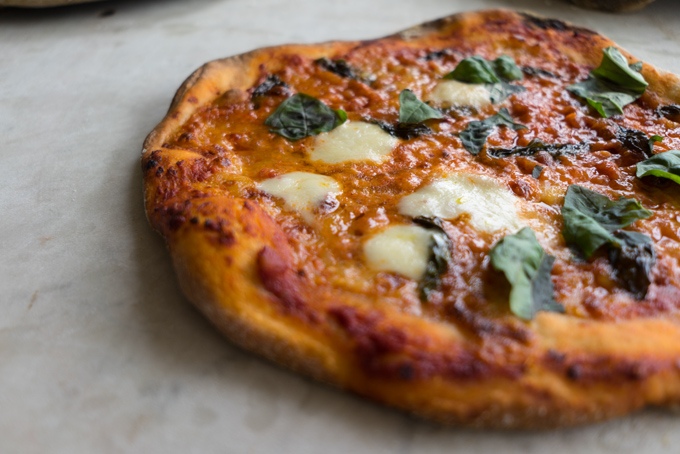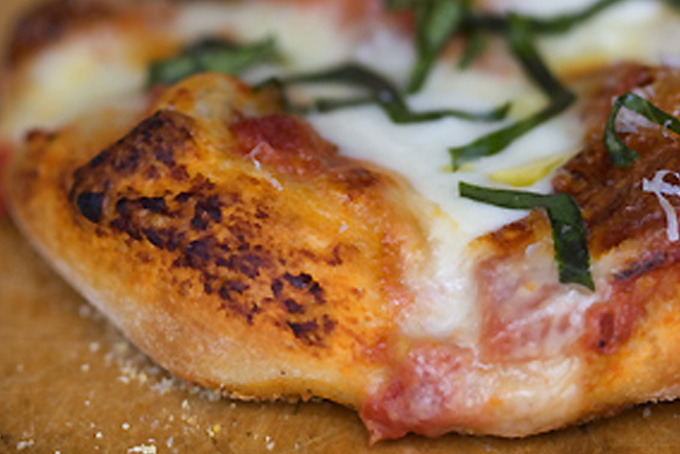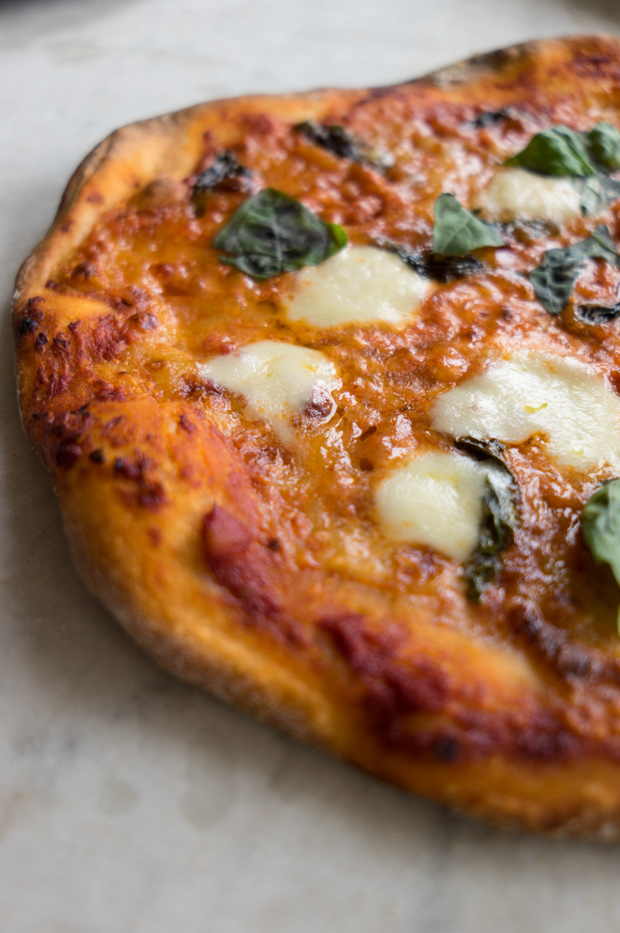So I have been experimenting with how to get to the best pizza dough. Sometimes that is as simple as a drive to "Dough", a neapolitan pizzeria not too far from our neighborhood. They make their dough, mozzarella, and sauce every day and it is wonderful. Still the desire to make my own pizza dough takes over periodically. I was happy to stumble upon this recipe and cannot wait to try it and report back. The following is from 101 Cookbooks:

Best Pizza Dough Ever Recipe
I can make a mean pizza, but it took me a while to learn how. Maybe I should rephrase that - I can make a mean pizza, but it took me a while to find the right teacher. For a long time I didn't really know where to look for guidance - I just knew I wanted pizza the way I'd enjoyed it in Rome and Naples.
I was smart enough to know early on, if you have bad pizza dough, you're destined to have bad pizza. Figuring out the dough factor was not as easy as you might think. As I got going, my oven gobbled up the fruits of many deflated attempts - a little yeast here, a lot of yeast there, this flour, that flour, knead by hand, knead by mixer, high baking temps, lower baking temps, and on and on.

Then I was given a hint. A gift, really. My friends and I would visit a favorite tiny pizza place in San Francisco quite often. We would go to eat, but also to try to absorb some of the good pizza karma flowing from their single-shelf, Baker's Pride oven. We spent a lot of time there, not because we wanted to know their secrets really - but primarily because the food was so good. We would end up chatting for hours over thin-crusts and more thin-crusts. One could see the flour shipments come in, the cheese deliveries transpire, and the wine selections rotate through the seasons. All the while, my homespun pizzas weren't improving much. Its not that they were bad, it was more that the dough was temperamental and tasted so-so. I wanted a dough that was on the thin side, crunched a bit as you bit into it, with minimal cardboard factor. And I knew, for this endeavor, I was not interested in a chewy, bready, or deep-dish type crust.
One day in the aforementioned pizza shop, I noticed a copy of Peter Reinhart's Bread Baker's Apprentice on a bookshelf near the prep area. It must have been quite new at the time, and my curiosity was piqued. Sure enough, the book contained an interesting (and meticulous) description of how to make just the sort of pizza I was after. The dough Peter uses for his Napoletana pizza in this book is rooted in a delayed-fermentation method - different from the other techniques I'd tried up to that point.
If you like to wait until the last minute to make pizza dough, you are out of luck here. The key is the overnight fermentation. You end up with a golden, beautiful crust with the perfect amount of crunch and subtle yeasty undertones. If you try this recipe and like it, Peter also went on to write an entire book about the quest for the perfect pizza, fittingly titled, American Pie. It's a great reference for those of you who really want to geek out on pizza.

Give Peter's dough a try, and if you are interested in baking world exceptional breads, be sure to spend time with his book. He is also working on a new book and I hope I'll get to hear more about him if I see him in March.
I'm just going to leave you with the dough recipe. It's up to you to play around with the toppings. The best advice I can give you is to take it easy on that front - a little goes a long way. My favorite is a simple pizza margherita with this tomato sauce, a few torn up bocconcini cow's milk mozzarella balls, and a few pinches of salt on the front end before placing the pizza in the oven. When the pizza comes out of the oven, I give it a quick dusting of grated Parmesan, a tiny drizzle of artisan-quality virgin olive oil, and a bit of basil cut into a chiffonade.
As far as oven temperatures go - I have great results at 450F degrees WITH a pizza stone. Go buy a pizza stone immediately if you are serious about making great pizza at home. They are cheap and make a huge difference in your crust.
This is the stripped-down, adapted version of Peter's Napoletana pizza dough recipe, if you want all his great side notes, tips, and back-history on the recipe, you are going to want to pick up the book - this (for example) is the meat of a recipe that spans six pages.
- More Basic Techniques -
Peter Reinhart's Napoletana Pizza Dough Recipe
Heidi notes: Peter's recipe says the olive (or vegetable oil) is optional. I use it every time - always olive oil, not vegetable oil. I love the moisture and suppleness it adds to the dough, and it makes your hands soft too.
4 1/2 cups (20.25 ounces) unbleached high-gluten, bread, or all-purpose flour, chilled
1 3/4 (.44 ounce) teaspoons salt
1 teaspoon (.11 ounce) instant yeast
1/4 cup (2 ounces) olive oil (optional)
1 3/4 cups (14 ounces) water, ice cold (40°F)
Semolina flour OR cornmeal for dusting
1. Stir together the flour, salt, and instant yeast in a 4-quart bowl (or in the bowl of an electric mixer). With a large metal spoon, stir in the oil and the cold water until the flour is all absorbed (or mix on low speed with the paddle attachment), If you are mixing by hand, repeatedly dip one of your hands or the metal spoon into cold water and use it, much like a dough hook, to work the dough vigorously into a smooth mass while rotating the bowl in a circular motion with the other hand. Reverse the circular motion a few times to develop the gluten further. Do this for 5 to 7 minutes, or until the dough is smooth and the ingredients are evenly distributed. If you are using an electric mixer, switch to the dough hook and mix on medium speed for 5 to 7 minutes, or as long as it takes to create a smooth, sticky dough. The dough should clear the sides of the bowl but stick to the bottom of the bowl. If the dough is too wet and doesn't come off the sides of the bowl, sprinkle in some more flour just until it clears the sides. If it clears the bottom of the bowl, dribble in a tea- spoon or two of cold water. The finished dough will be springy, elastic, and sticky, not just tacky, and register 50 to 55F.
2. Sprinkle flour on the counter and transfer the dough to the counter. Prepare a sheet pan by lining it with baking parchment and misting the parchment with spray oil (or lightly oil the parchment). Using a metal dough scraper, cut the dough into 6 equal pieces (or larger if you are comfortable shaping large pizzas), You can dip the scraper into the water between cuts to keep the dough from sticking to it, Sprinkle flour over the dough. Make sure your hands are dry and then flour them. Lift each piece and gently round it into a ball. If the dough sticks to your hands, dip your hands into the flour again. Transfer the dough balls to the sheet pan, Mist the dough generously with spray oil and slip the pan into a food-grade plastic bag.
3. Put the pan into the refrigerator overnight to rest the dough, or keep for up to 3 days. (Note: If you want to save some of the dough for future baking, you can store the dough balls in a zippered freezer bag. Dip each dough ball into a bowl that has a few tablespoons of oil in it, rolling the dough in the oil, and then put each ball into a separate bag. You can place the bags into the freezer for up to 3 months. Transfer them to the refrigerator the day before you plan to make pizza.)
4. On the day you plan to make the pizza, remove the desired number of dough balls from the refrigerator 2 hours before making the pizza. Before letting the dough rest at room temperature for 2 hours, dust the counter with flour, and then mist the counter with spray oil. Place the dough balls on top of the floured counter and sprinkle them with flour; dust your hands with flour. Gently press the dough into flat disks about 1/2 inch thick and 5 inches in diameter. Sprinkle the dough with flour, mist it again with spray oil, and cover the dough loosely with plastic wrap or a food-grade plastic bag. Now let rest for 2 hours.
5. At least 45 minutes before making the pizza, place a baking stone either on the floor of the oven (for gas ovens), or on a rack in the lower third of the oven. Heat the oven as hot as possible, up to 800F (most home ovens will go only to 500 to 550F, but some will go higher). If you do not have a baking stone, you can use the back of a sheet pan, but do not preheat the pan.
6. Generously dust a peel or the back of a sheet pan with semolina flour or cornmeal. Make the pizzas one at a time. Dip your hands, including the backs of your hands and knuckles, in flour and lift I piece of dough by getting under it with a pastry scraper. Very gently lay the dough across your fists and carefully stretch it by bouncing the dough in a circular motion on your hands, carefully giving it a little stretch with each bounce. If it begins to stick to your hands, lay it down on the floured counter and reflour your hands, then continue shaping it. Once the dough has expanded outward, move to a full toss as shown on page 208. If you have trouble tossing the dough, or if the dough keeps springing back, let it rest for 5 to 20 minutes so the gluten can relax, and try again. You can also resort to using a rolling pin, though this isn't as effective as the toss method.
7. When the dough is stretched out to your satisfaction (about 9 to 12 inches in diameter for a 6-ounce piece of dough), lay it on the peel or pan, making sure there is enough semolina flour or cornmeal to allow it to slide. Lightly top it with sauce and then with your other top- pings, remembering that the best pizzas are topped with a less-is-more philosophy. The American "kitchen sink" approach is counterproductive, as it makes the crust more difficult to bake. A few, usually no more than 3 or 4 toppings, including sauce and cheese is sufficient.
8. Slide the topped pizza onto the stone (or bake directly on the sheet pan) and close the door. Wait 2 minutes, then take a peek. If it needs to be rotated 180 degrees for even baking, do so. The pizza should take about 5 to 8 minutes to bake. If the top gets done before the bottom, you will need to move the stone to a lower self before the next round. if the bottom crisps before the cheese caramelizes, then you will need to raise the stone for subsequent bakes.
9. Remove the pizza from the oven and transfer to a cutting board. Wait 3 to 5 minutes before slicing and serving, to allow the cheese to set slightly.
Makes six 6-ounce pizza crusts.
from The Bread Baker's Apprentice by Peter Reinhart (Ten Speed Press) - reprinted with permission.
Prep time: 20 min
No comments:
Post a Comment